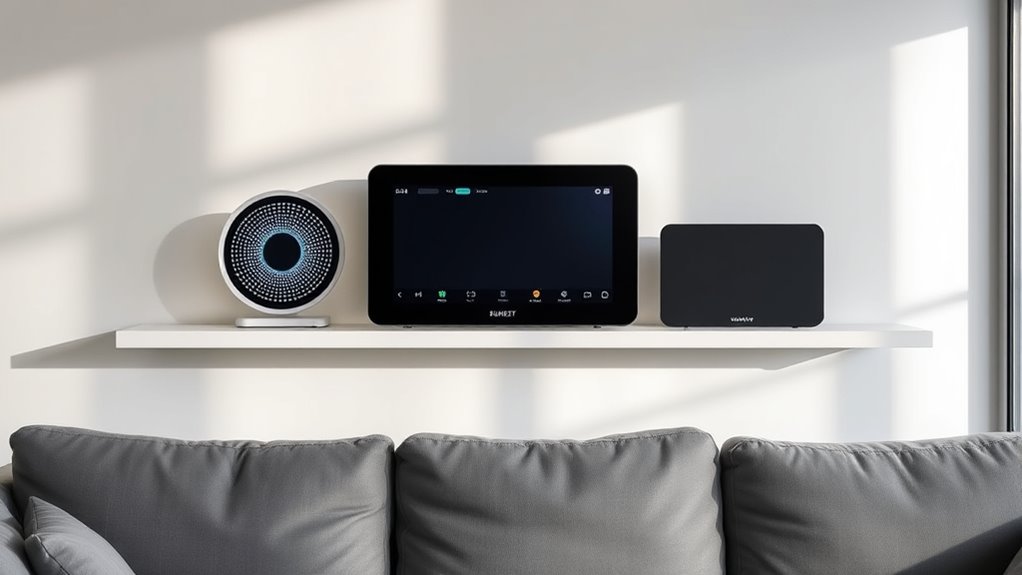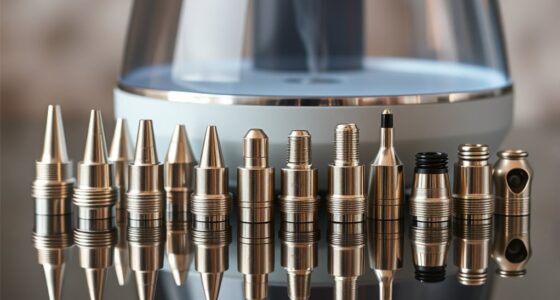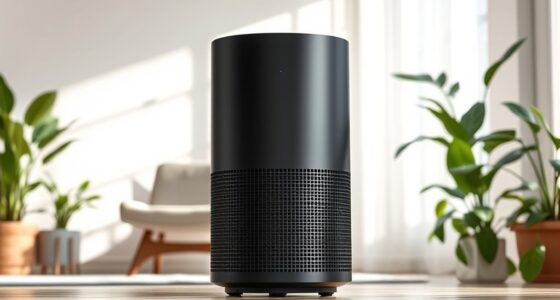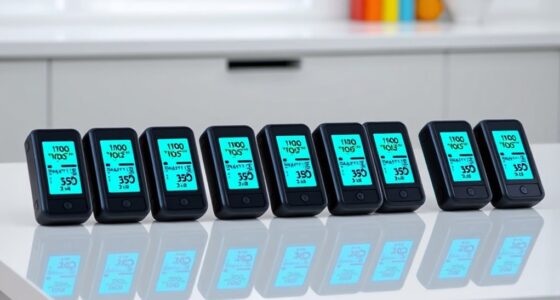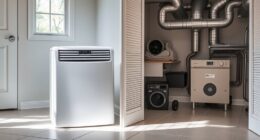If you’re looking for the best smart air quality monitors, I recommend devices with easy-to-read displays, multiple sensors like CO₂, formaldehyde, and VOCs, plus real-time data updates. Features such as Wi-Fi connectivity, compatibility with Alexa or Apple HomeKit, and customizable alerts are essential for seamless integration. Portable options with long battery life make monitoring convenient anywhere. Keep exploring further to find the perfect device that suits your smart home and air safety needs.
Key Takeaways
- Look for monitors with Wi-Fi or Zigbee support for seamless integration with smart home ecosystems like Alexa, Google Home, or Apple HomeKit.
- Prioritize devices with real-time data, customizable alerts, and automation capabilities to proactively manage indoor air quality.
- Choose models featuring accurate, lab-grade sensors for pollutants such as CO₂, VOCs, formaldehyde, and particulate matter.
- Consider monitors with user-friendly interfaces, clear displays, and easy setup to ensure quick, effortless operation.
- Opt for portable, battery-powered options that enable flexible placement and continuous monitoring across different environments.
Air Quality Monitor with CO2, HCHO, TVOC, Temperature & Humidity
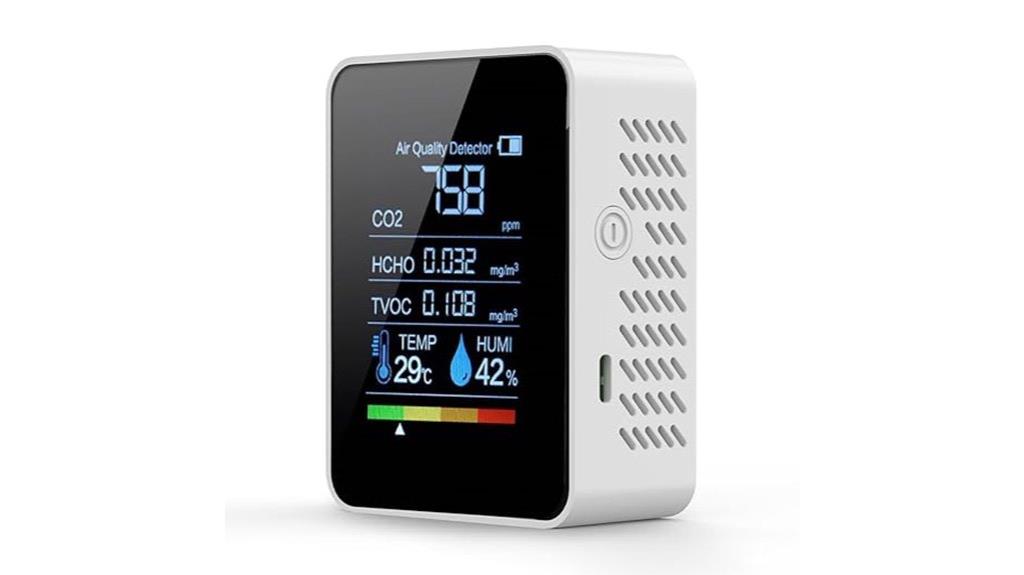
If you’re looking for a reliable way to monitor your indoor air quality, the Air Quality Monitor with CO2, HCHO, TVOC, temperature, and humidity is an excellent choice. It provides detailed data with a clear, bright display and real-time updates, making it easy to track airborne pollutants and climate conditions. Its compact, lightweight design allows portability across various environments, from homes to offices. Easy to set up via USB-C, it offers an accurate, high-precision sensor system that detects elevated pollutant levels effectively. Although battery life can vary, its real-time alerts help you act quickly to improve your indoor air safety.
Best For: individuals and families seeking real-time, comprehensive indoor air quality monitoring to ensure a healthy environment at home, in the office, or on the go.
Pros:
- Provides accurate, real-time data on CO2, HCHO, TVOC, temperature, and humidity with a clear, bright display.
- Portable and lightweight design allows easy use across various settings, including outdoor environments.
- Easy setup via USB-C with user-friendly interface and helpful alerts for poor air quality.
Cons:
- Battery life may be shorter than advertised, with some users experiencing only a few hours of use.
- Limited trend analysis features in the app, making long-term monitoring and data tracking challenging.
- Some measurements like humidity and temperature may slightly differ from external reference devices.
Qingping Air Quality Monitor Gen 2, Indoor Air Quality Tester with Alarm Function
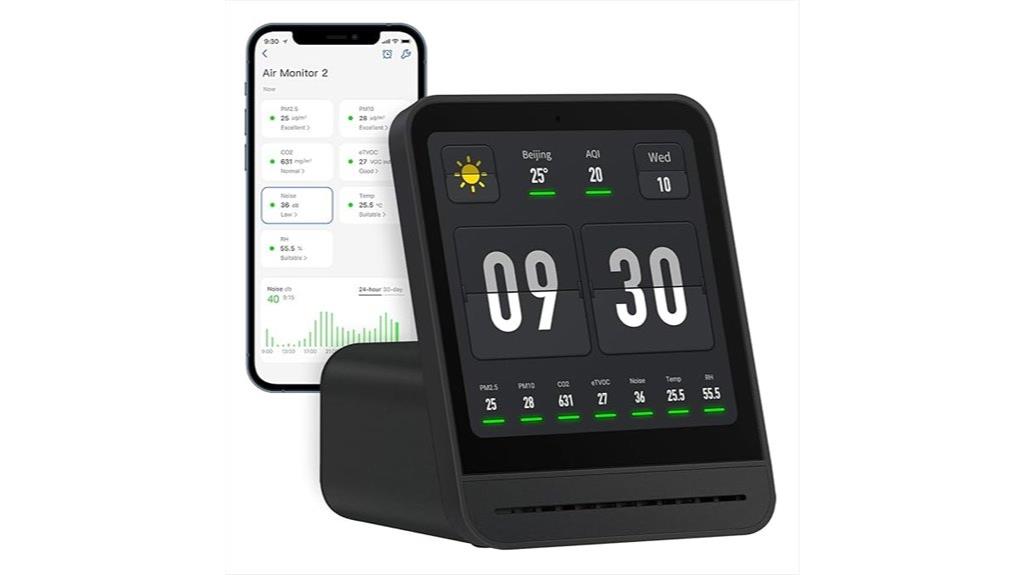
The Qingping Air Quality Monitor Gen 2 stands out for its all-encompassing tracking of seven key indoor air quality metrics, making it ideal for anyone serious about maintaining a healthy environment. It monitors PM2.5, PM10, CO2, temperature, humidity, eTVOC, and noise levels, providing a thorough view of indoor air. Its high-resolution touchscreen displays data clearly, with color indicators for quick assessment. The device features an alarm function to alert you to poor air quality and supports Wi-Fi for remote monitoring via the Qingping+ app. Easy to operate, it’s a reliable tool for maintaining ideal indoor air conditions, especially with continuous power support.
Best For: households and individuals seeking comprehensive indoor air quality monitoring to ensure a healthy and comfortable environment.
Pros:
- Monitors 7 key air quality metrics including PM2.5, CO2, and noise for thorough indoor environment assessment.
- High-resolution touchscreen with color indicators provides easy, quick understanding of air quality status.
- Supports Wi-Fi connectivity and app integration for remote monitoring and data export.
Cons:
- Does not measure formaldehyde levels, limiting full indoor air quality assessment.
- Requires continuous power via USB, which may limit portability or placement options.
- Battery life is limited to about 3 hours on a full charge, necessitating constant power for long-term use.
Air Quality Monitor, Professional Air Quality Detector
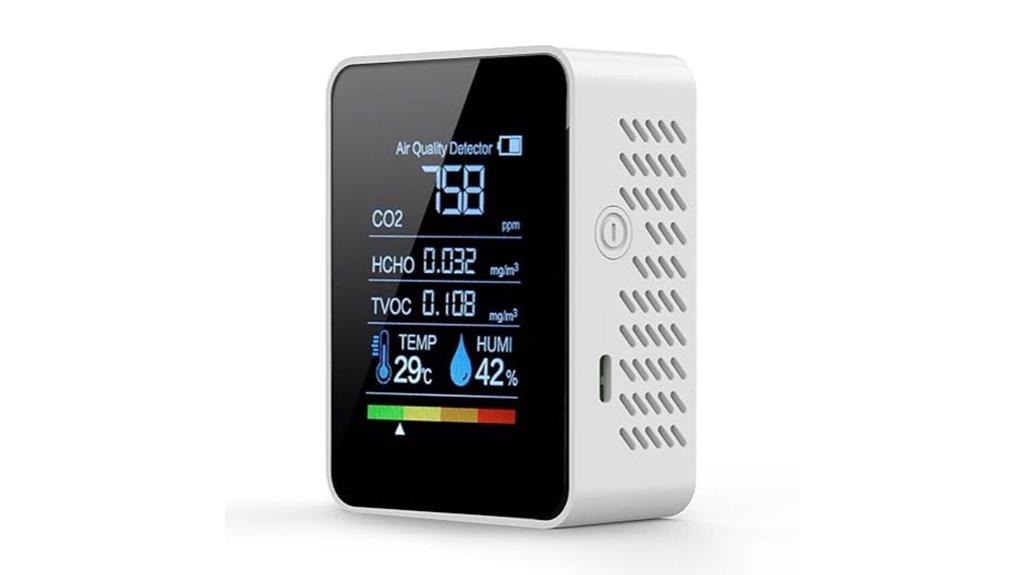
A home automation air quality monitor stands out for its ability to provide thorough and real-time data on multiple indoor pollutants, making it ideal for anyone serious about maintaining a healthy environment. This 5-in-1 device measures CO2, formaldehyde, VOCs, temperature, and humidity, offering a complete view of indoor air quality. It features a bright display, simple USB-C setup, and alerts for poor air conditions, prompting immediate action. Its compact, portable design allows use anywhere—home, office, or vehicle. Equipped with advanced sensors, it delivers accurate, real-time data, helping you identify and address pollutants quickly, ensuring a safer, healthier indoor environment.
Best For: individuals seeking real-time, comprehensive indoor air quality monitoring to maintain a healthy living or working environment.
Pros:
- Provides accurate, real-time data on CO2, formaldehyde, VOCs, temperature, and humidity.
- Compact, portable design suitable for use in various settings including home, office, and vehicles.
- Easy to set up with a user-friendly interface and clear bright display.
Cons:
- Battery life may be shorter than advertised, with some users experiencing only a few hours of use.
- Charging cables can be challenging to manage and may affect overall convenience.
- Lacks trend analysis features via an app, limiting long-term monitoring and data tracking.
Bonoch 16-in-1 Indoor Air Quality Monitor with 7 Display and AQI Alerts
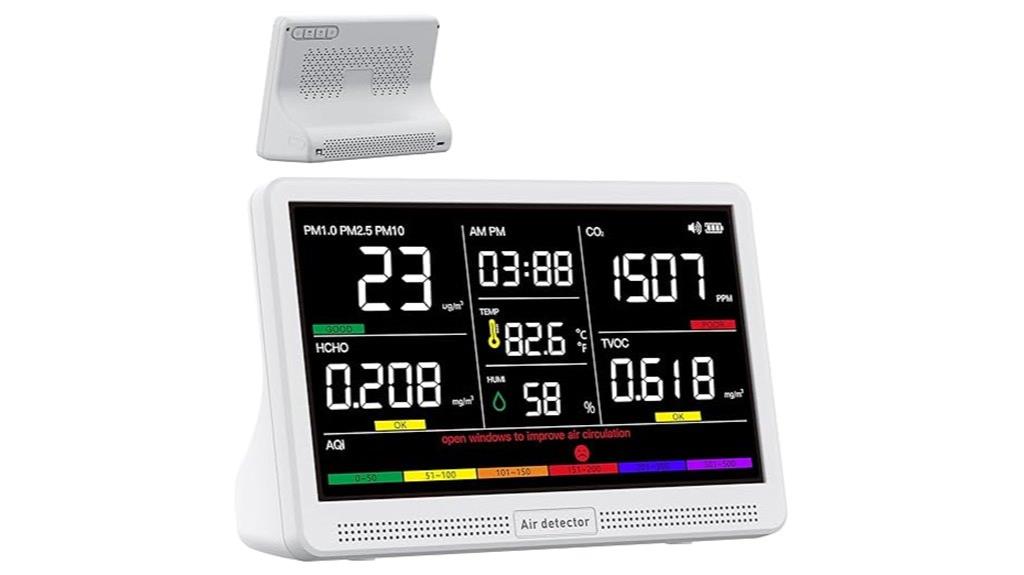
For those serious about maintaining ideal indoor air quality, the Bonoch 16-in-1 Indoor Air Quality Monitor stands out with its large, easy-to-read 7-inch display and customizable AQI alerts. It tracks nine key parameters, including CO2, PM levels, formaldehyde, TVOC, temperature, and humidity, providing all-encompassing insights. Its high-precision sensors deliver lab-grade accuracy, detecting even minor fluctuations. The device offers instant notifications through seven alert alarms, so you can respond proactively. With adjustable brightness and user-friendly controls, it’s designed for effortless operation. Overall, this monitor combines advanced technology with practicality, making it a valuable addition to any smart home aiming for healthier indoor air.
Best For: Homeowners and health-conscious individuals seeking comprehensive, real-time indoor air quality monitoring with customizable alerts and high accuracy.
Pros:
- Measures nine essential air quality parameters including CO2, PM levels, formaldehyde, and TVOC for thorough insights.
- Features a large 7-inch HD display with adjustable brightness for easy readability in various lighting conditions.
- Provides instant, customizable AQI alerts and alarms to enable proactive health management.
Cons:
- External sensors require careful handling to maintain accuracy; touching sensors or exposing them to strong odors can affect performance.
- The device may be more expensive compared to basic air quality monitors due to its advanced features.
- Requires occasional calibration and maintenance to ensure sustained sensor precision over time.
Amazon Smart Air Quality Monitor – Know your air, Works with Alexa
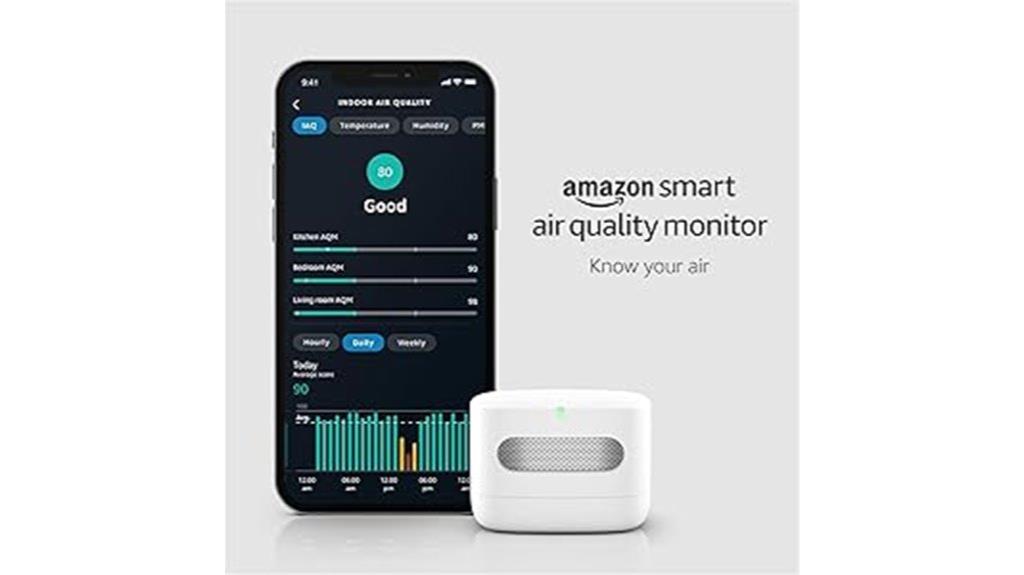
If you want to effortlessly monitor your indoor air quality and get real-time insights, the Amazon Smart Air Quality Monitor is an excellent choice, especially if you already use Alexa devices. It tracks five key factors—PM 2.5, VOCs, CO, humidity, and temperature—and displays air quality with a color-coded LED and an easy-to-understand score in the Alexa app. The device sends alerts or announcements when air quality drops, keeping you informed. Plus, it integrates with Alexa routines, allowing automation of compatible devices like purifiers and fans to maintain ideal conditions automatically. Setup is simple, making it accessible even for those new to smart home tech.
Best For: smart home enthusiasts seeking an easy-to-use air quality monitor that seamlessly integrates with Alexa for real-time insights and automation.
Pros:
- Tracks five key indoor air factors including PM 2.5, VOCs, CO, humidity, and temperature for comprehensive air quality monitoring
- Provides real-time alerts and notifications via the Alexa app or Echo devices to keep you informed
- Supports automation routines to control compatible devices like purifiers and fans automatically based on air quality data
Cons:
- Limited to indoor air quality monitoring; does not measure outdoor air conditions
- Requires an Alexa-enabled device for full functionality and automation features
- May be less effective in larger spaces or multi-room setups without additional sensors
16-in-1 Indoor Air Quality Monitor with Digital Display
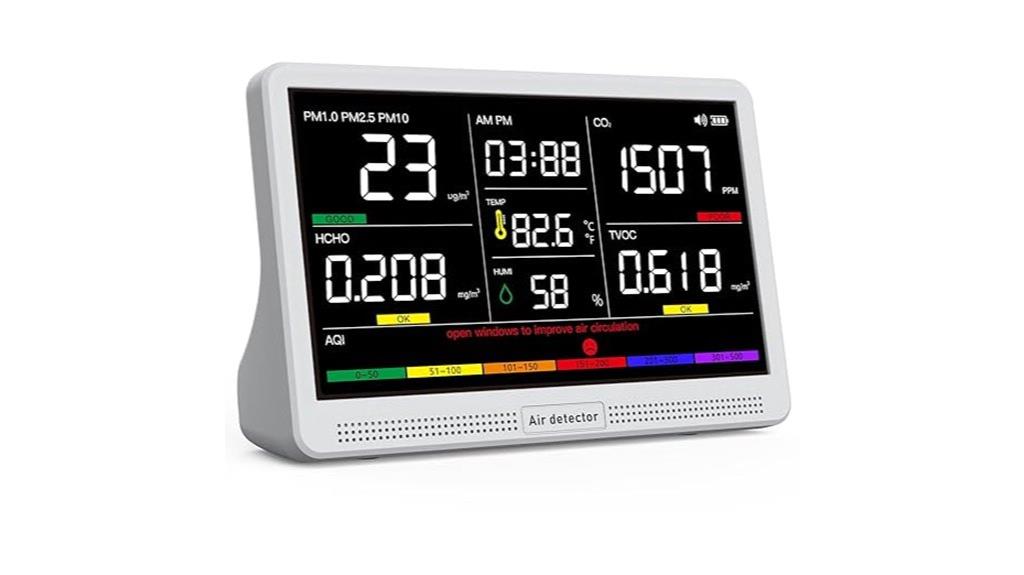
The 16-in-1 Indoor Air Quality Monitor with Digital Display stands out as an ideal choice for homeowners who want all-encompassing, real-time insights into their indoor environment without relying on smartphone apps or complex setup. It detects nine key parameters, including CO2, PM levels, formaldehyde, VOCs, temperature, humidity, and AQI, displaying all data clearly on a large 7-inch LED screen. With adjustable brightness, color-coded alerts, and seven AQI buzzers, it’s user-friendly and informative. Setup is quick—plug in, and it starts monitoring immediately. Its high-precision sensors ensure reliable readings, making it a practical, straightforward tool to help you maintain healthier indoor air quality.
Best For: homeowners and indoor environment enthusiasts seeking a comprehensive, easy-to-use air quality monitor with real-time data and no need for smartphone integration.
Pros:
- Provides real-time data on nine key air quality parameters with a large, clear LED display.
- User-friendly setup with adjustable brightness, color-coded alerts, and simple controls.
- High-precision external sensors ensure reliable readings for effective indoor air management.
Cons:
- Bulky design may limit placement options and reduce portability.
- Some users report discrepancies in CO2 readings compared to professional measurements.
- Operates primarily on wall power with limited battery backup, reducing mobility during power outages.
BREATHE Airmonitor Plus: Smart Indoor Air Quality Monitor
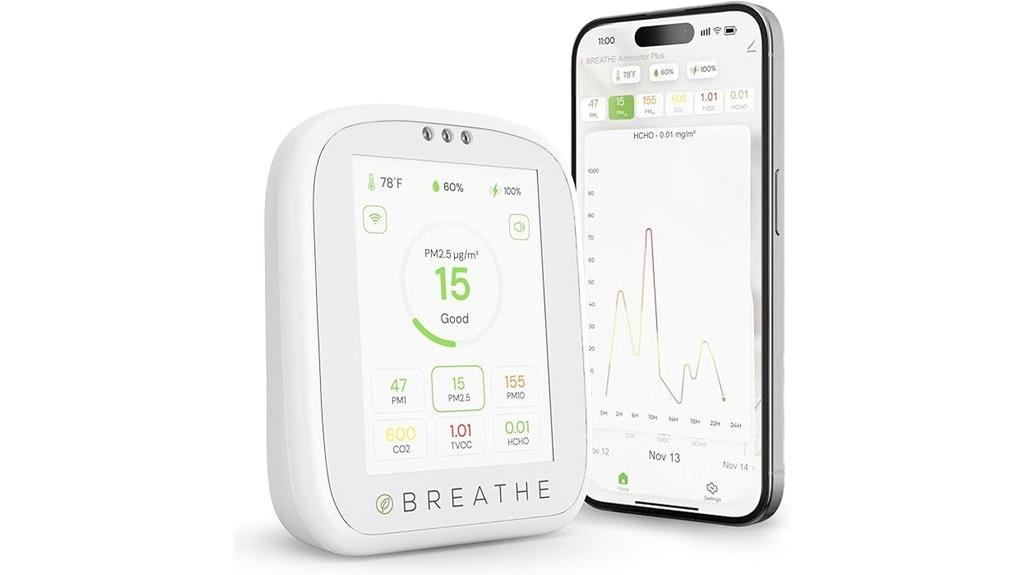
The BREATHE Airmonitor Plus stands out as an ideal choice for homeowners who want thorough, real-time insights into their indoor air quality. It offers 8-in-1 monitoring, tracking PM1, PM2.5, PM10, CO2, TVOC, formaldehyde, temperature, and humidity, giving a complete picture of your environment. Its high-precision sensors ensure accurate readings, and the Wi-Fi-connected app lets you monitor remotely, set alerts, and view trends. Portable with a built-in battery, it’s easy to set up and use across multiple rooms. Despite some limitations like short battery life, its sleek design and extensive data make it a top pick for healthier indoor living.
Best For: homeowners and indoor environment enthusiasts seeking comprehensive, real-time air quality monitoring to ensure healthier living spaces.
Pros:
- Provides 8-in-1 measurement of key indoor pollutants and environmental factors for a complete air quality assessment
- High-precision sensors deliver accurate real-time data, supporting proactive health and safety measures
- Portable design with a built-in battery allows testing across multiple rooms and outdoor environments
Cons:
- Limited battery life of only 2-3 hours restricts continuous or extended use without recharging
- Wi-Fi connectivity issues reported by some users may hinder seamless remote monitoring and data access
- Lacks Bluetooth setup and local data logging features, which could enhance usability and offline functionality
Professional Indoor Air Quality Monitor with AQI Beep Alarms
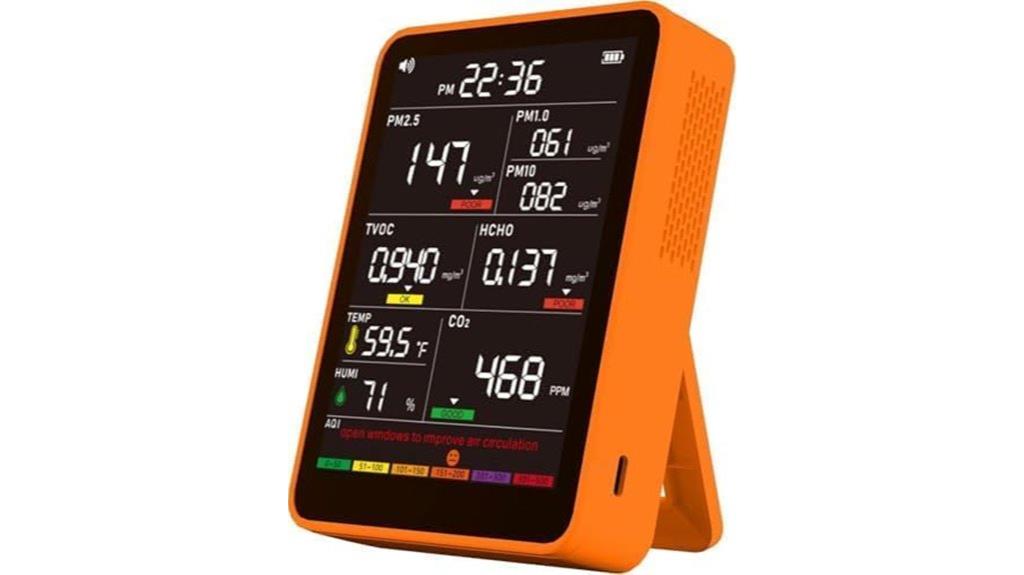
A professional indoor air quality monitor with AQI beep alarms stands out as an ideal choice for homeowners who prioritize safety and quick response. Its sleek design and portability make it perfect for use at home, in cars, or outdoors. The device provides real-time data on PM, CO₂, TVOC, formaldehyde, temperature, and humidity, with a clear HD display. Its seven alarm types emit distinct sounds to alert you immediately when air quality drops. Powered by a rechargeable battery offering 4-5 hours of wireless use, it’s easy to recharge and move around. The device’s accuracy, simple controls, and reliable alerts make it a smart addition to any indoor air quality management plan.
Best For: homeowners, car owners, and outdoor enthusiasts seeking reliable, real-time indoor air quality monitoring with instant alerts.
Pros:
- Provides accurate, real-time detection of multiple air quality indicators including PM, CO₂, TVOC, and formaldehyde.
- Features a clear HD color display with visual indicators and distinct AQI beep alarms for quick assessment and prompt action.
- Portable with versatile mounting options, long battery life, and fast charging, suitable for various environments like home, car, and outdoor settings.
Cons:
- Limited wireless operation time of 4-5 hours per charge may require frequent recharging for continuous use.
- The device’s size and weight, while portable, may still be cumbersome for some users to carry around frequently.
- As a portable monitor, it may not replace more comprehensive professional testing for detailed air quality analysis.
Air Quality Monitor Indoor, 8-in-1 Smart Air Quality Tester
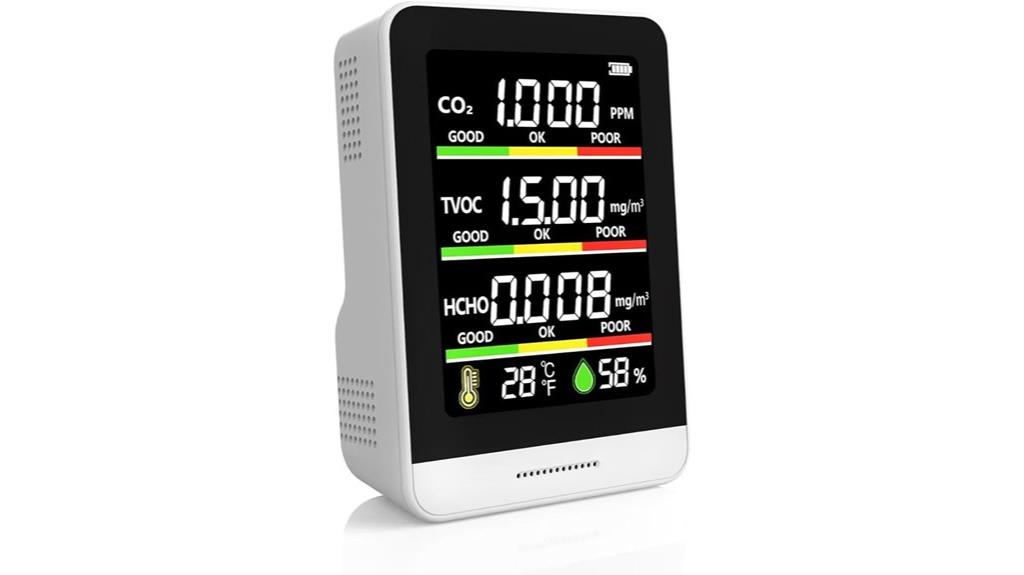
If you want a reliable way to monitor indoor air quality effortlessly, this 8-in-1 smart air quality tester is an excellent choice. It measures AQI, CO2, formaldehyde, TVOC, temperature, and humidity, providing extensive insights with a clear, color-coded display. Compact and lightweight, it’s battery-powered with a 9-10 hour runtime and charges in just a few hours via Type-C. The device offers fast, accurate readings within seconds, thanks to high-performance sensors, and includes an audible alarm for quick alerts. Its user-friendly controls and portability make it perfect for monitoring various rooms, helping you maintain a healthier indoor environment effortlessly.
Best For: individuals seeking a reliable, easy-to-use indoor air quality monitor to ensure a healthy and comfortable living or working environment.
Pros:
- Provides comprehensive 8-in-1 measurement of AQI, CO2, HCHO, TVOC, temperature, and humidity for thorough environmental insights.
- Fast, accurate readings within seconds thanks to high-performance sensors and dual ventilation technology.
- Portable and lightweight with a long battery life, making it easy to monitor multiple rooms effortlessly.
Cons:
- May require calibration over time to maintain measurement accuracy.
- Limited to indoor use; not suitable for outdoor air quality monitoring.
- The display and controls, while user-friendly, might still be challenging for those with limited technical familiarity.
12-in-1 Indoor Air Quality Monitor with Portable Tester for CO2, PM1.0, PM2.5, HCHO, TVOC
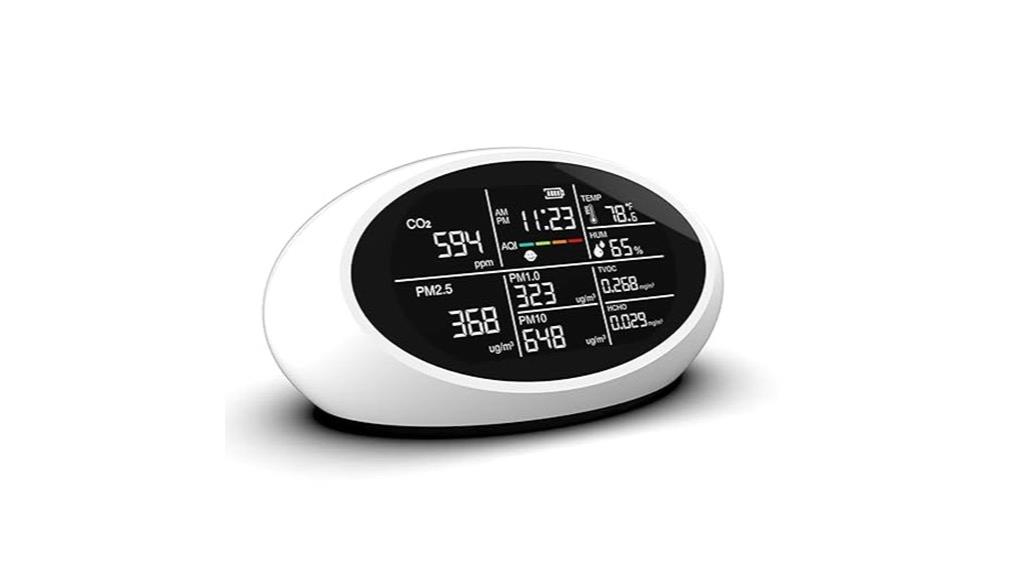
For those seeking a versatile and easy-to-use air quality solution, the Rozoroo 12-in-1 Indoor Air Quality Monitor stands out with its portable design and all-encompassing sensor suite. It measures CO2, PM1.0, PM2.5, HCHO, and TVOC in real-time, providing precise data that helps me quickly assess indoor safety. Its stylish, skin-friendly build makes it suitable everywhere—from home to office or car. With a powerful 5000 mAh battery supporting wireless and wired use, I can move it effortlessly across environments. The intuitive interface and quick setup mean I get instant insights, and the built-in alarms keep me alerted to unsafe conditions.
Best For: individuals and organizations seeking a portable, comprehensive, and easy-to-use indoor air quality monitor to ensure a safe and healthy environment across homes, offices, vehicles, and medical settings.
Pros:
- Provides real-time, high-accuracy measurements of multiple air quality parameters including CO2, PM1.0, PM2.5, HCHO, and TVOC.
- Portable and stylish design with a long-lasting 5000 mAh battery supports wireless and wired operation for versatile use.
- User-friendly with quick setup, intuitive controls, and built-in safety alarms for immediate alerts on unsafe air conditions.
Cons:
- May require periodic calibration to maintain measurement accuracy over time.
- The device’s detailed sensor suite could be complex for users unfamiliar with air quality metrics.
- Availability of responsive customer service within 24 hours might vary depending on location.
12-in-1 Portable Indoor Air Quality Monitor

The 12-in-1 Portable Indoor Air Quality Monitor stands out as an ideal choice for anyone seeking real-time, all-encompassing air monitoring on the go. It features multiple sensors that track CO2, TVOC, PM1.0, PM2.5, PM10, humidity, temperature, and time, providing a thorough view of your environment. Its upgraded dual-chip architecture ensures accurate and stable readings quickly. Easy to set up in just a minute, it offers intuitive controls with simple buttons and clear visual indicators like smiley faces and alarms. Whether at home, work, or traveling, this portable device keeps you informed and protected, ensuring healthier indoor air wherever you go.
Best For: individuals seeking a portable, comprehensive air quality monitoring solution for home, office, or travel environments.
Pros:
- Provides real-time, multi-parameter air quality data including CO2, TVOC, PM levels, humidity, and temperature.
- Upgraded dual-chip architecture ensures fast, stable, and accurate measurements.
- Easy setup and intuitive controls with visual indicators like smiley faces and alarms for quick assessment.
Cons:
- May require frequent calibration for optimal accuracy over time.
- Limited to indoor environments; less effective for outdoor air quality monitoring.
- Battery life and wireless connectivity could vary depending on usage and device model.
Professional Indoor Air Quality Monitor with AQI Beep Alarms

A professional indoor air quality monitor with AQI beep alarms is ideal for anyone who values real-time, reliable data to maintain a safe environment. Its sleek, portable design makes it easy to move between rooms, cars, or outdoor spaces. Equipped with high-precision sensors, it measures PM, CO₂, TVOC, formaldehyde, temperature, and humidity every three seconds. The device features seven distinct AQI alert sounds, prompting immediate action when air quality drops. With a large HD display and simple controls, it’s user-friendly for all. Powered by rechargeable batteries, it offers up to five hours of wireless operation, ensuring continuous monitoring wherever you need it most.
Best For: individuals seeking a reliable, portable indoor air quality monitor to ensure a safe environment at home, in vehicles, or outdoors.
Pros:
- High-precision sensors provide real-time, professional-grade air quality data every 3 seconds
- Easy-to-use with a large HD display, simple controls, and effective AQI beep alarms for immediate alerts
- Compact, lightweight, and portable design with versatile mounting options for various settings
Cons:
- Battery life of up to 5 hours may require frequent recharging during extended use
- Limited to wireless operation when not plugged in, which might restrict continuous monitoring in some scenarios
- The device’s features and alarms may be overwhelming for users seeking a basic air quality monitor
Professional Indoor Air Quality Monitor, 5-in-1 Portable Smart Air Tester

If you’re looking for a reliable way to monitor indoor air quality on the go, this 5-in-1 portable smart air tester is an excellent choice. It accurately measures CO2, HCHO, TVOC, temperature, and humidity in real time, providing exhaustive data for safe living environments. Its high-definition color screen displays clear, easy-to-understand information, with color-changing alerts to warn of unsafe air quality. Built with advanced sensors, it offers high sensitivity and stability. Compact and lightweight, it’s perfect for use at home, in your car, or outdoors, with a rechargeable battery lasting up to 8 hours. Simple to operate and highly versatile, it’s an essential tool for indoor air monitoring on the go.
Best For: those seeking a portable, all-in-one indoor air quality monitoring device for home, car, or outdoor use to ensure a safe environment.
Pros:
- Accurate real-time detection of CO2, HCHO, TVOC, temperature, and humidity with advanced sensors.
- High-definition color display with clear data visualization and real-time environmental assessment.
- Compact, lightweight design with up to 8 hours of rechargeable battery life, ideal for on-the-go monitoring.
Cons:
- Requires manual calibration for optimal accuracy over time.
- Limited to 8 hours of continuous use per charge, which may not suffice for extended monitoring needs.
- May be less suitable for professional-grade environmental analysis compared to larger, more advanced systems.
GoveeLife Smart Air Quality Monitor
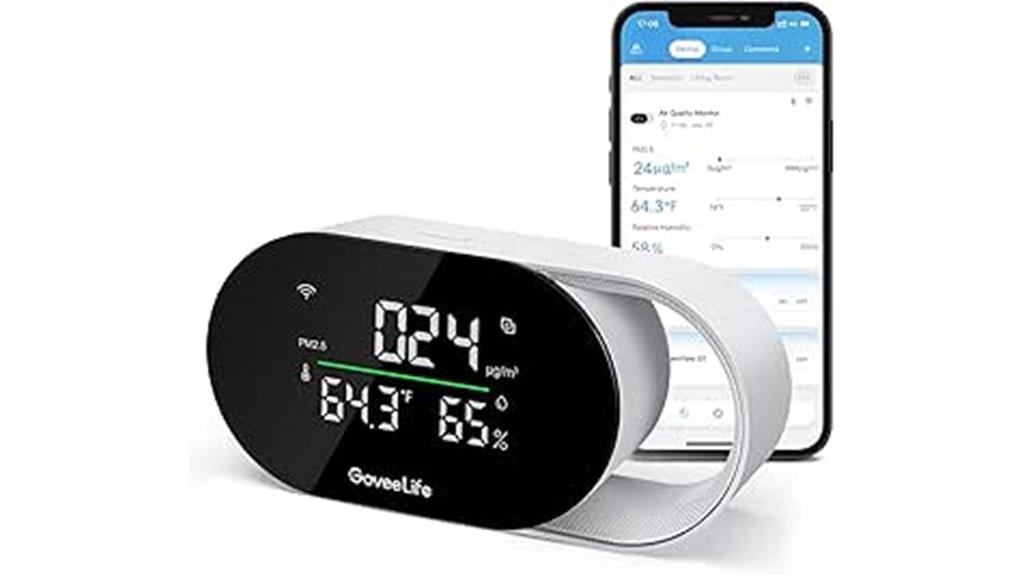
For those seeking an affordable and easy-to-use air quality monitor that seamlessly integrates with smart home systems, the GoveeLife Smart Air Quality Monitor is an excellent choice. Its sleek, compact design fits well in any home or office. It measures PM2.5, temperature, and humidity with quick updates every two seconds, providing real-time data. Compatible with GoveeHome devices, it can trigger automated responses like turning on air purifiers or humidifiers. Users appreciate its accuracy and straightforward setup. While it doesn’t monitor VOCs or CO2, its affordability and smart automation capabilities make it a practical tool for improving indoor air quality effortlessly.
Best For: those looking for an affordable, easy-to-use indoor air quality monitor that integrates seamlessly with smart home systems for real-time environmental management.
Pros:
- Accurate measurement of PM2.5, temperature, and humidity with rapid updates every 2 seconds.
- Compact, sleek design that easily fits into various home or office spaces.
- Supports smart home automation by connecting with Govee appliances for automated air quality control.
Cons:
- Does not monitor VOCs, CO2, or other specific pollutants, limiting comprehensive air quality assessment.
- Connectivity issues may arise with Wi-Fi, especially on 2.4 GHz networks.
- Lacks advanced sensors for gases like CO or combustible gases, which could enhance its functionality.
Eve Room Indoor Air Quality Sensor
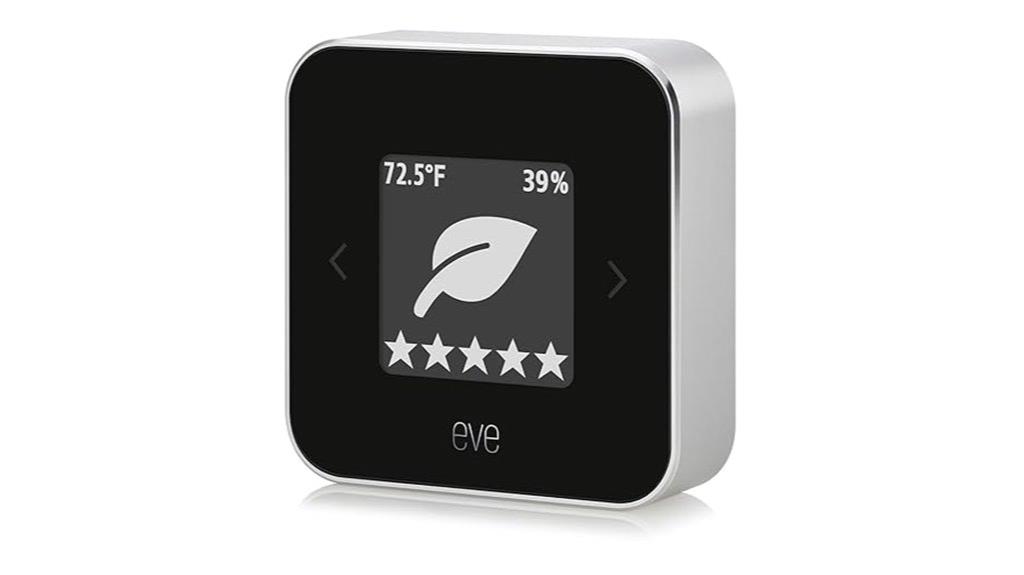
The Eve Room Indoor Air Quality Sensor stands out for its sleek, minimalist design combined with advanced sensor technology, making it ideal for homeowners who prioritize both aesthetics and accurate environmental monitoring. It tracks VOCs, temperature, and humidity in real time, providing quick snapshots via color-coded indicators. Its second-generation model is smaller, rechargeable, and discreet, fitting seamlessly into any home. With Bluetooth and Thread connectivity, setup is simple, and it integrates smoothly with Apple HomeKit. The device offers detailed data via the Eve app, helping you monitor trends and maintain healthy indoor air quality. Users appreciate its accuracy, design, and privacy-focused operation.
Best For: homeowners seeking a stylish, easy-to-setup indoor air quality monitor with strong privacy features and seamless Apple HomeKit integration.
Pros:
- Sleek, minimalist design that blends well with home decor
- Accurate detection of VOCs, temperature, and humidity with real-time data
- Privacy-focused operation with no cloud dependency and local data storage
Cons:
- Limited compatibility with non-Apple smart home ecosystems like Google Home
- App navigation can be cumbersome for accessing detailed data
- Occasional calibration issues or minor hardware glitches reported by users
Factors to Consider When Choosing a Home Automation‑Ready Air Quality Monitor
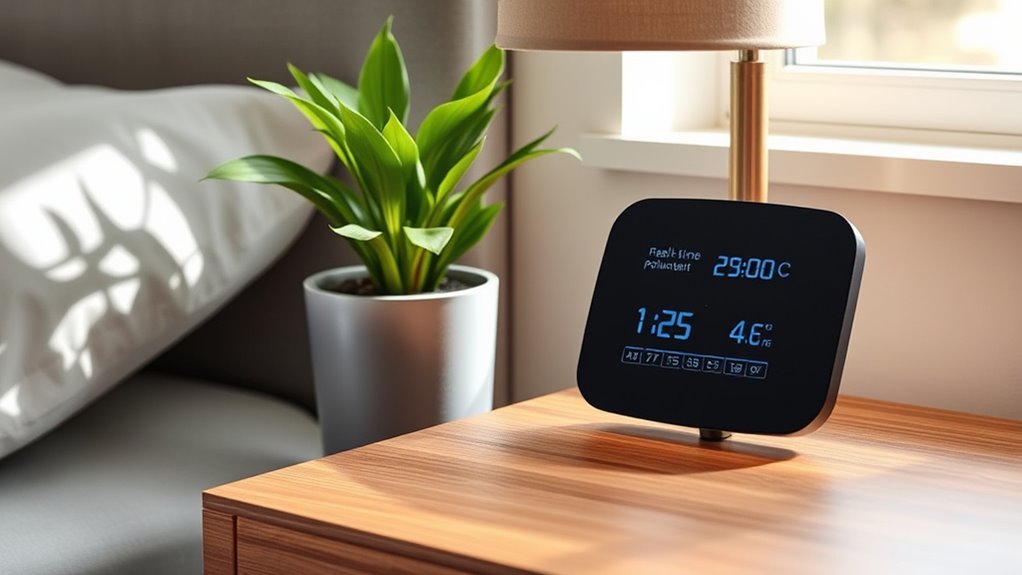
When selecting a home automation-ready air quality monitor, I focus on how well it works with my existing devices and how accurate its sensors are. I also consider how easy it is to set up and customize alerts, along with its battery life to make certain of continuous monitoring. These factors help me find a unit that fits seamlessly into my smart home and provides reliable data.
Compatibility With Smart Devices
Choosing a home automation-ready air quality monitor requires guaranteeing it can seamlessly connect with your existing smart devices. First, check if it supports common protocols like Wi-Fi, Bluetooth, Thread, or Zigbee, so it integrates smoothly into your setup. Compatibility with popular platforms such as Apple HomeKit, Alexa, or Google Assistant is essential for easy voice control and automation routines. Additionally, verify if the monitor offers APIs or supports third-party apps to customize automation and data management. It’s also helpful if it can connect with compatible appliances like air purifiers, humidifiers, or thermostats for synchronized operation. Finally, review the device’s firmware update policies and compatibility notes to ensure your monitor remains compatible as your smart home ecosystem evolves.
Sensor Accuracy and Range
Ensuring your air quality monitor provides accurate readings depends heavily on the sensors it uses. High-precision sensors, like NDIR for CO2 and electrochemical for formaldehyde, are essential for reliable measurements within narrow tolerances. The sensor’s measurement range should cover typical indoor pollutant levels—0-5000 ppm for CO2 and 0-10 mg/m³ for formaldehyde—to detect both normal and hazardous conditions. Sensitivity is critical; it determines how well the device detects even minor fluctuations, enabling timely alerts and better health protection. Additionally, calibration stability over time is indispensable; features like auto-calibration or manual options help maintain accuracy. A combination of advanced sensor technology and multi-parameter detection offers a thorough, trustworthy view of your indoor air quality.
Ease of Integration
Integrating an air quality monitor into your smart home setup is straightforward when it supports common protocols like Wi-Fi, Zigbee, or Thread, which guarantee seamless communication with your existing devices. Checking compatibility with popular platforms such as Amazon Alexa, Google Home, or Apple HomeKit ensures smooth control and automation. Look for monitors that can trigger other devices, like purifiers or fans, based on air quality data—this automation enhances your indoor environment effortlessly. Make sure the device connects easily to your smart hub or app without complex setup steps. Additionally, open APIs or integration support allow for custom routines and data sharing, giving you flexibility to expand your smart home ecosystem. Ease of integration is key to creating a truly automated and responsive indoor air quality system.
Alert Customization Options
Once you’ve confirmed that your air quality monitor supports smart home integration, it’s important to contemplate how well it allows you to customize alerts. I look for devices that let me set personalized thresholds for pollutants like CO2, VOCs, and particulate matter, so I can stay informed without false alarms. Multi-channel alarms with different sounds help me identify specific issues quickly. I also prefer monitors that offer alert modes such as visual notifications, push alerts, or automated responses like turning on air purifiers. The ability to create multiple profiles for different times or activities is a big plus, allowing tailored alerts for various scenarios. Ultimately, adjustable alert sensitivity and notification frequency help me customize my experience to suit my household’s needs.
Battery Life & Power
Battery life is a critical factor when choosing a home automation-ready air quality monitor, especially if you plan to use it in portable or hard-to-reach locations. A long-lasting battery ensures continuous monitoring without frequent recharging, which is essential for maintaining reliable data. Devices with rechargeable batteries often support quick charging, reducing downtime and keeping the monitor operational. Power options like USB-C or external adapters add flexibility for placement and integration into smart home systems. Keep in mind that battery performance can vary depending on sensor activity, display brightness, and connectivity features, which all impact runtime. Some monitors also include low-battery alerts, so you’ll be notified when recharging is needed, preventing gaps in data collection during critical monitoring periods.
Data Visualization Features
Choosing a home automation-ready air quality monitor with effective data visualization features is essential for easily understanding and acting on air quality information. Clear, color-coded displays with green, yellow, and red indicators allow me to instantly grasp the current air quality status at a glance. Graphical tools like trend lines and historical charts help me track changes over time and spot patterns. Customizable dashboards and alerts let me prioritize critical parameters and receive timely notifications about unsafe conditions. Intuitive user interfaces with simple controls such as taps, slides, or toggles make exploring complex data quick and effortless. High-resolution screens and real-time updates ensure I get accurate, visually appealing, and accessible environmental metrics, making it easier to maintain a healthy indoor environment.
Connectivity Stability
A stable connection is essential when selecting a home automation-ready air quality monitor because it guarantees I receive continuous real-time data and timely alerts. A strong Wi-Fi signal with minimal interference reduces the risk of disconnections that could delay critical notifications. Dual-band support (2.4GHz and 5GHz) helps by allowing the monitor to switch seamlessly between bands, maintaining stability even in crowded networks. Consistent network connectivity is also crucial for cloud-based features, such as remote access and data synchronization, ensuring I can monitor air quality from anywhere. Regular firmware updates from manufacturers help improve connection stability by fixing bugs and optimizing network compatibility. Overall, reliable connectivity guarantees the monitor functions smoothly and keeps me informed about my indoor air quality without interruption.
Monitoring Parameters Offered
When selecting a home automation-ready air quality monitor, it’s important to consider the range of parameters it measures, as this determines how thoroughly it can assess your indoor environment. Many monitors track key factors like CO2, VOCs, formaldehyde, PM2.5, PM10, temperature, and humidity, providing a comprehensive view of air quality. Some devices also include sensors for noise levels, AQI, or specific pollutants, enabling more detailed insights and automation triggers. Sensor accuracy and detection range vary, with high-end models offering real-time updates and lab-grade precision for critical parameters. Monitoring data is often displayed via color indicators, digital readouts, or connected apps, making it easy to interpret and respond quickly. Your specific needs, like allergy management or ventilation, will guide the best parameter selection.
Frequently Asked Questions
How Do I Integrate Air Quality Monitors With Existing Smart Home Systems?
Integrating air quality monitors with your existing smart home system is pretty straightforward. First, check if your monitor is compatible with your smart hub or voice assistant, like Alexa or Google Home. Then, connect it via Wi-Fi or Bluetooth, using the app provided. Once set up, you can automate actions like adjusting ventilation or alerting you when air quality drops. It’s a simple way to keep your indoor air healthy.
What Is the Typical Lifespan of Sensors in These Air Quality Monitors?
You’re probably wondering about the sensor lifespan in air quality monitors. Typically, sensors last around 6 to 12 months, depending on usage and the specific device. Some high-quality monitors have replaceable sensors, which extend their lifespan. Regular calibration and maintenance can also help sensors stay accurate longer. I recommend checking the manufacturer’s guidelines for the most precise information for your particular model.
Can These Monitors Detect All Common Indoor Air Pollutants Accurately?
You’re wondering if these monitors can detect all common indoor air pollutants accurately. I’ve found that most high-quality monitors are great at identifying key pollutants like VOCs, particulate matter, and CO2, but they might struggle with some specific gases or chemicals. While they provide a solid overall picture, for absolute precision on every pollutant, specialized sensors or lab testing may still be necessary.
Are Maintenance and Calibration Required for Consistent Performance?
Imagine I neglected regular calibration, and my monitor showed false air quality readings. I learned that maintenance and calibration are essential for consistent accuracy. Most monitors, like the ones I researched, require periodic checks—usually every few months— to guarantee their sensors stay precise. Without this, you risk misjudging your indoor air quality, which could impact your health. So, yes, regular upkeep is definitely necessary for reliable performance.
How Do I Interpret the AQI and Sensor Readings Effectively?
When I look at AQI and sensor readings, I focus on the color codes and numerical values. A lower AQI means better air quality, while higher numbers indicate pollution. I check for specific pollutants like PM2.5 or CO2 levels to understand what’s affecting my air. If readings are high, I open windows or turn on air purifiers. Regular monitoring helps me keep my indoor environment safe and comfortable.
Conclusion
Choosing the right home automation-ready air quality monitor is about more than just numbers; it’s about peace of mind. Whether you prefer sleek design or advanced features, each device offers a way to breathe easier and live smarter. It’s the difference between ignoring your air and actively improving it. Because in the end, a healthier home isn’t just a goal—it’s the foundation for a better life. Your perfect monitor awaits.
